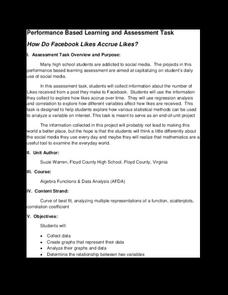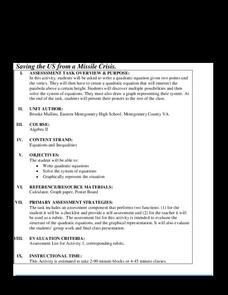Radford University
Tiling
What more could we want from floor tiles? Using pattern blocks and graph paper, pupils determine ways to completely tile a floor of given dimensions. They consider the aesthetic quality of the tiles by creating a tessellation and...
Radford University
Marking Starting Locations for the 400-Meter Dash Track and Field Event
No fair! I had to run more than they did! Young mathematicians first measure various lengths on a school track. They develop strategies and show calculations to prove that all participants will run the same length using a staggered...
Radford University
Escape from the Zombie Apocalypse - Exploring Quadrilaterals through Google Maps and Google Earth
Prepare for the zombie apocalypse ... by studying quadrilaterals? Given a map of an imaginary town, scholars identify quadrilaterals created by streets. They then use Google Earth and Google Maps to find parallelograms, rectangles,...
Radford University
Movie Projector Cost
Small groups analyze the attendance at a movie theater and determine the amount of money made for per show. Team members calculate the number of shows it would take for a theater to make a profit after purchasing a new digital projector....
Radford University
Calculating the Cost: Algebraic Planning for a First Car
Scholars decide which job to take based on the pay. They then research cars to potentially purchase and determine the total cost of the car. Finally, they calculate how long they would have to work to purchase the car along with how much...
Radford University
Translating and Evaluating Cell Phone Plans
Translate phone plans to algebraic expressions. Pupils review translating verbal phrases to algebraic expressions by filling out graphic organizers and completing matching activities. Using a fictitious cell phone company, they create...
Radford University
Throwing a Football
Use mathematics to help the football team. Pairs brainstorm how to approach finding a solution to a problem to help the quarterback complete more passes. By researching and collecting data, the teams derive an equation to represent the...
Radford University
Fuel Efficient Function Activity
Pupils research the five most fuel efficient vehicles of the same type and come up with a way to display the mile per gallon for each vehicle. After choosing a vehicle, scholars create graphs to display miles traveled given the amount of...
Radford University
How Do Facebook Likes Accrue Likes?
Finally, a project pupils will instantly like! Young mathematicians collect data on the number of likes they receive for a social media post over time. During the first part of the project, they determine a curve of best fit and...
Radford University
Saving the US from a Missile Crisis
Mathematically shoot down an incoming missile. Given information about the Cuban Missile Crises, learners calculate the equation of the trajectory of an imaginary missile launched from Cuba toward Washington, D.C. Scholars determine the...
Radford University
Discovering Quadratics
Get to know quadratics from a couple of different perspectives. Classmates work in small groups to determine the optimal cooking time for microwave popcorn. Group members pop bags of popcorn for different times and collect data on the...
Radford University
Survey Activity
It's time to take a survey. After looking at an example of a survey on lunch preferences, groups design their own surveys. They consider the sample size and sampling technique, then conduct the surveys. As a final activity, they create...
Radford University
Statistical Study
Put your knowledge of sample surveys to good use. Pupils begin by conducting a survey of class members. They identify an appropriate topic and sampling technique; collect and organize their data; compute and analyze statistical measures;...
Radford University
Exploring Types of Variation Activity
Create a variable list of problems. Groups come up with four scenarios. Each situation represents different types of variation, direct, inverse, joint, and combined. Teams then generate questions about their contextual problems for...
Curated OER
Counting Money and Making Change
Students count collections of coins and one-dollar bills. They solve problems and learn to use the dollar sign ($) with the decimal point to represent money amounts. This lesson is important as a foundation for future math concepts in...
Curated OER
Estimate, Solve, and Check
Young scholars estimate, solve, and check a series of addition and subtraction number and word problems. They write their estimates on a recording sheet, compute and write the answer in the next column, and check their answer with a...
Curated OER
The Attack of the Manhole Monsters
Learners explore the concept of similarity. They examine such topics as ratio of corresponding sides, internal ratios and scaling factors. After watching a video, student groups perform experiments outside the school building.
Curated OER
100th Day of School
Young scholars participate in various motor skill activities while counting to 100. These activities are designed to go with the 100th day of school. They will complete various tasks such as jumping rope, tossing, running, and catching...
Illustrative Mathematics
Shape Hunt Part 1
The hunt is on! Send young mathematicians on a search for shapes in the first instructional activity of this two-part series. Each time a child finds a hidden shape, he draws it on his paper, and continues searching for the rest. Perform...
Curated OER
Through India and Back
Students play a game based on "The Amazing Race" to practice using rates and fractions. In this fractions and rates lesson, students work in small groups competing to complete the tasks in the quickest time. At each stage of the journey,...
Curated OER
Numeral Dough Mats
Kinesthetic learners will have a great time with numbers as they play with colored dough using these numeral recognition mats. The resource outlines number 0-9, each large enough for a full-page. Print them out and laminate, then use in...
Curated OER
Mathematics of Fair Games
Students examine mathematicians' notion of fairness in games of chance. They work in pairs to perform three different experiments using macaroni and paper bags. They record their results on charts and compare their data.
Curated OER
Is the Rainbow Fair?
Third graders perform statistical calculations. Given a bag of Skittles, 3rd graders sort and collect data regarding the colors included in their bag. Using spreadsheet software, students create a bar graph of the information collected....
Curated OER
Number Line Up
A simple counting activity to help your kindergartners count in sequence. Hand out number cards randomly (one to represent each child in your class) to each class member. Now ask the class to put themselves in sequential order beginning...

























